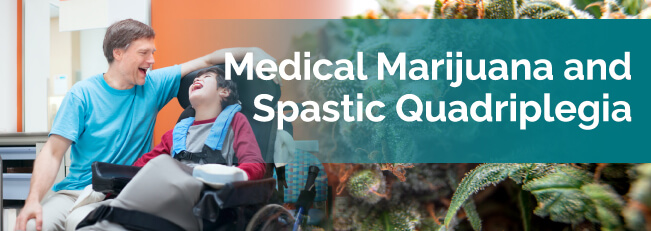
Cerebral palsy is a disorder affecting half a million people in the United States alone. This condition develops in infants and small children due to brain injury or malformation. Symptoms differ from person to person, but one of the most common symptoms of CP is muscle spasticity. This is an irregularity in skeletal muscle performance causing tight muscles and exaggerated reflexes.
Spasticity can affect one side of the body more than the other. It can also be isolated to one, two or even three limbs — spastic quadriplegia refers to spasticity affecting all four limbs. This condition is a rare form of spastic cerebral palsy.
There is no cure for cerebral palsy, but the condition never worsens. However, symptoms associated with the condition can deteriorate over time. Medical marijuana is an effective treatment for many of the symptoms caused by spastic quadriplegia. Read on to see if cannabis could effectively help your condition.
Spastic quadriplegia presents a range of symptoms, all affecting a person’s musculature. These usually develop before a child reaches two years of age and can include:
Because of these severe contractions, patients with spastic quadriplegia can develop other painful conditions and symptoms, such as:
Although there’s no complete cure for the symptoms associated with spastic quadriplegia, it’s important that patients treat the condition before it worsens. If left untreated, an individual’s musculature can be severely impacted, and the severity of the symptoms will increase over time.
Some possible treatments for spastic quadriplegia include:
There hasn’t been enough research dedicated to the effects of medical marijuana on cerebral palsy conditions. However, the limited studies that have been conducted have shown favorable results. There’s also an abundance of anecdotal evidence that supports the use of cannabis as a positive treatment option for spastic quadriplegia.
Three major symptoms caused by this disorder have shown marked improvement from medical marijuana treatments:
Cannabis has two major cannabinoids: tetrahydrocannabinol (THC) and cannabidiol (CBD). Both compounds act upon the endocannabinoid system, reducing these symptoms.
Although more research is required, states through the U.S. agree with the findings. Many have added spastic quadriplegia and cerebral palsy to the list of qualifying conditions for their medical marijuana programs. Even states that don’t include these conditions specifically allow patients to seek cannabis treatments for symptoms associated with the disorder — muscle spasms, chronic pain and seizures.
If you or a loved one have spastic quadriplegia, make an appointment with a medical marijuana doctortoday to get on the road to better health.
For more information about how cannabis can be used to treat Cerebral Palsy, check out our resources: